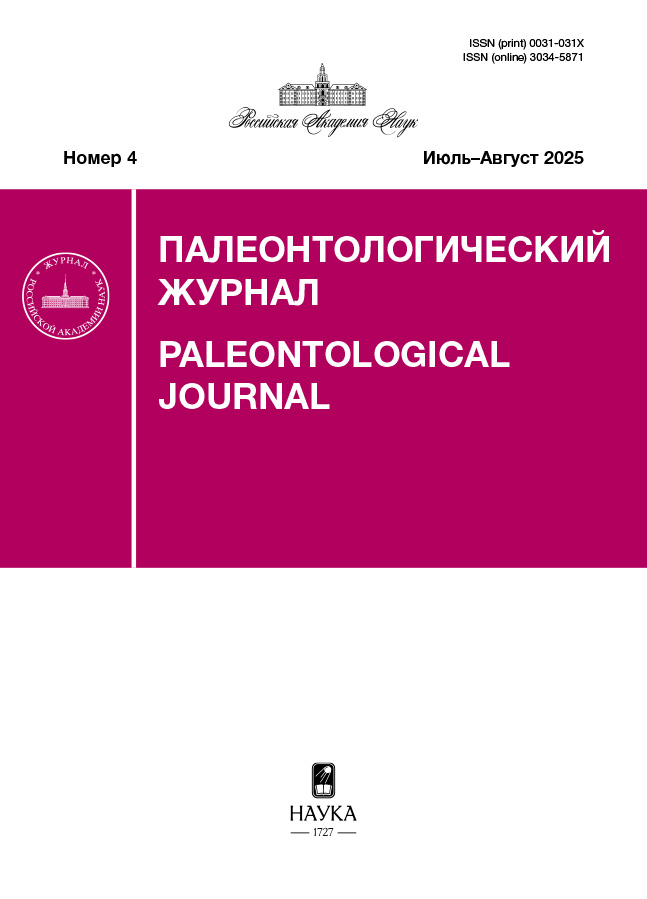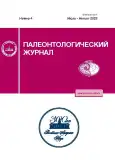Новая антилопа Tavridia gromovi gen. et sp. nov. (Artiodactyla, Bovidae) из нижнего плейстоцена пещеры Таврида в Крыму
- Авторы: Вислобокова И.А.1
-
Учреждения:
- Палеонтологический институт им. А.А. Борисяка РАН
- Выпуск: № 4 (2023)
- Страницы: 106-115
- Раздел: Статьи
- URL: https://journals.rcsi.science/0031-031X/article/view/137121
- DOI: https://doi.org/10.31857/S0031031X23040141
- EDN: https://elibrary.ru/OHVBJP
- ID: 137121
Цитировать
Полный текст
Аннотация
Дано описание новой формы антилопы из нижнего плейстоцена пещеры Таврида в Центральном Крыму. Новый род и вид Tavridia gromovi выделен по фрагменту крыши черепа с роговым стержнем и нижней челюсти. Эта небольшая антилопа отличалась от всех известных форм особенностями строения роговых стержней и зубной системы. По совокупности признаков она отнесена к трибе Antilopini Gray, 1821. Находка в Крыму свидетельствует о значительном разнообразии этой группы антилоп в раннем плейстоцене.
Ключевые слова
Об авторах
И. А. Вислобокова
Палеонтологический институт им. А.А. Борисяка РАН
Автор, ответственный за переписку.
Email: ivisl@paleo.ru
Россия, 117647, Москва
Список литературы
- Вислобокова И.А., Титов В.В., Лавров А.В. и др. Раннеплейстоценовые винторогие антилопы (Artiodactyla, Bovidae) из пещеры Таврида (Крым, Россия) // Палеонтол. журн. 2020. № 1. С. 78–88.
- Дмитриева Е.Л. Антилопы неогена Монголии и сопредельных территорий. М.: Наука, 1977. 120 с.
- Лопатин А.В., Вислобокова И.А., Лавров А.В. и др. Пещера Таврида – новое местонахождение раннеплейстоценовых позвоночных в Крыму // Докл. Акад. наук. 2019. Т. 485. № 3. С. 381–385.
- Хан M.A., Ахтар M. Антилопы (Mammalia: Ruminantia, Bovidae) из верхнесиваликских отложений местонахождения Татрот (Пакистан), с описанием нового вида // Палеонтол. журн. 2014. № 1. С. 80–91.
- Alcalá L., Morales J. Antilopinae (Bovidae, Mammalia) from the Lower Pliocene of Teruel Basin (Spain) // Estud. Geol. 2006. V. 62. № 1. P. 559–570.
- Bärmann E.V., Rössner G.E., Wörheide G. A revised phylogeny of Antilopini (Bovidae, Artiodactyla) using combined mitochondrial and nuclear genes // Mol. Phylog. Evol. 2013. V. 67. P. 484–493.
- Bibi F. A multi-calibrated mitochondrial phylogeny of extant Bovidae (Artiodactyla, Ruminantia) and the importance of the fossil record to systematics // BMC Evol. Biol. 2013. V. 13. № 166. 15 p.
- Bibi F. Assembling the ruminant tree: combining morphology, molecules, extant taxa, and fossils // Zitteliana. 2014. Bd 32. P. 197–211.
- Bibi F., Bukhsianidze M., Gentry A.W. et al. The fossil record and evolution of Bovidae: State of the field // Palaeontol. Electron. 2009. V. 12. Iss. 3. 10A. 10 p.
- Boehme M., Spassov N., Ebner M. et al. Messinian age and savannah environment of the possible hominin Graecopithecus from Europe // PLoS ONE. 2017. V. 12. № 5. e0177347.
- Bouvrain G., de Bonis L. Découverte du genre Hispanodorcas (Bovidae, Artiodactyla) dans le Turolien de Gréce septentrionale // Ann. Paléontol. 1988. V. 74. P. 97–112.
- Bukhsianidze M. The fossil Bovidae of Dmanisi. Doct. Thesis. Ferrara: Univ. Ferrara, 2005. 192 p.
- Cain III J.W., Krausman P.R., Germaine H.L. Antidorcas marsupialis // Mammalian Species. 2004. № 753. P. 1–7.
- Castelló J.R. Bovids of the World: Antelopes, Gazelles, Cattle, Goats, Sheep, and Relatives. Princeton Univ. Press, 2016. 664 p.
- Chen L., Qiu Q., Jiang, Y. et al. Large-scale ruminant genome sequencing provides insights into their evolution and distinct traits // Science. 2019. V. 364. № 6446. aav6202. P. 1–12.
- Crégut-Bonnoure E. Apport des Caprinae et Antilopinae (Mammalia, Bovidae) à la biostratigraphie du Pliocène terminal et du Pléistocène d’Europe // Quaternaire. 2007. V. 18. № 1. P. 73–97.
- deMenocal P.B. African climate change and faunal evolution during the Pliocene–Pleistocene // Earth Planet. Sci. Lett. 2004. V. 220. P. 3–24.
- Ecker M., Lee-Thorp J.A. The dietary ecology of the extinct springbok Antidorcas bondi // Quatern. Intern. 2018. V. 495. P. 136–143.
- Farke A.D. Evolution and functional morphology of the frontal sinuses in Bovidae (Mammalia: Artiodactyla), and implications for the evolution of cranial pneumaticity // Zool. J. Linn. Soc. 2010. V. 159. P. 988–1014.
- Gentry A.W. Fossil Antilopini of East Africa // Bull. Brit. Mus. (Natur. Hist.) Geol. 1966. V. 12. P. 45–106.
- Gentry A.W. Bovidae of the Omo Group deposits // Earliest Man and Environment in the Lake Rudolf Basin / Eds. Coppens Y. et al. Chicago: Univ. Chicago Press, 1976. P. 275–292.
- Gentry A.W. The Bovidae of the Omo Group deposits, Ethiopia // Les Faunes Plio-Pléistocènes de la Basse Vallée de l’Omo (Ethiopia), Vol. 1. Périssodactyles – Artiodactyles (Bovidae). P.: CNRS, 1985. P. 119–191.
- Gentry A.W. Evolution and dispersal of African Bovidae // Horns, Pronghorns, and Antlers / Eds. Bubenik G.A., Bubenik A.B. N.Y.: Springer, 1990. P. 195–227.
- Gentry A.W. The subfamilies and tribes of the family Bovidae // Mammal Review. 1992. V. 22. Iss. 1. P. 1–32.
- Gentry A.W. Bovidae // Cenozoic Mammals of Africa / Eds. Werdelin L., Sanders W.J. Berkeley: Univ. California Press, 2010. P. 741–796.
- Gentry A.W., Gentry A. Fossil Bovidae (Mammalia) of Olduvai Gorge, Tanzania // Bull. Brit. Mus. (Natur. Hist.) Geol. 1978. V. 29. P. 289–446.
- Gentry A.W., Rössner G.E., Heizmann E.P.J. Suborder Ruminantia // The Miocene Land Mammals of Europe / Eds. Rössner G.E., Heissig K. Munich: Verlag Dr. F. Pfeil, 1999. P. 225–258.
- Groves C., Grubb P. Ungulate Taxonomy. Baltimore: Johns Hopkins Univ. Press, 2011. 336 p.
- Hassanin A., Delsuc F., Ropiquet A. et al. Pattern and timing of diversification of Cetartiodactyla (Mammalia, Laurasiatheria), as revealed by a comprehensive analysis of mitochondrial genomes // C. R. Biol. 2012. V. 335. P. 32–50.
- Hassanin A., Douzery E.J.P. The tribal radiation of the family Bovidae (Artiodactyla) and the evolution of the mitochondrial cytochrome b gene // Mol. Phylog. Evol. 1999. V. 13. P. 227–243.
- IUCN SSC Antelope Specialist Group. Antilope cervicapra. The IUCN Red List of Threatened Species. 2017: e.T1681A50181949. P. 1–8.
- Lerp H., Wronski T., Butynski T.M., Plath M. Speciation of Arabian gazelles // Speciation: Natural Processes, Genetics and Biodiversity / Ed. Michalak P. N.Y.: Nova Science, 2013. P. 59–82.
- Kostopoulos D.S. Parastrepsiceros koufosi n. sp.; note on the possible presence of a Prostrepsiceros descendant in the latest Pliocene of Northern Greece // Acta Zool. Cracov. 1998. V. 41. P. 101–109.
- Kostopoulos D.S. Taxonomic re-assessment and phylogenetic relationships of Miocene homonymously spiral-horned antelopes // Acta Palaeontol. Pol. 2014. V. 59. P. 9–29.
- Kostopoulos D.S. The fossil record of bovids (Mammalia: Artiodactyla: Ruminantia: Pecora: Bovidae) in Greece // Fossil Vertebrates of Greece. Vol. 2. Laurasiatherians, Artiodactyles, Perissodactyles, Carnivorans, and Island Endemics / Ed. Vlachos E. Springer, 2022. P. 113–204.
- Kostopoulos D.S., Athanassiou A. Les gazelles du Pliocène moyen-terminal de la Grèce continentale (Macédoine, Thessalie) // N. Jb. Geol. Paläontol. Abh. 1997. Bd 205. P. 413–430.
- Lozano D.A., Blanco C.J. Estudio anatómico y funcional del aparato masticatorio del antílope negro (Antilope cervicapra, Artyodactyla, Bovidae) // InVet. 2018. V. 20. № 1–2. P. 39‒48.
- Matthee C.A., Robinson T.J. Cytochrome b phylogeny of the family Bovidae: resolution within the Alcelaphini, Antilopini, Neotragini, and Tragelaphini // Mol. Phylog. Evol. 1999. V. 12. № 1. P. 31–46.
- McKenna M.C., Bell S.K. Classification of Mammals: Above the Species Level. N.Y.: Columbia Univ. Press, 1997. 631 p.
- Pilgrim G.E. Siwalik antelopes and oxen in the American Museum of Natural History // Bull. Amer. Mus. Natur. Hist. 1937. V. 72. Art. 7. P. 729–874.
- Pilgrim G.E. The fossil Bovidae of India // Mem. Geol. Surv. Ind. N.S. 1939. V. 26. P. 1–356.
- Rodrigo M.A. Los bóvidos Villafranquiensis de la Puebla de Valverde y Villarroya: systemática, filogenia y paleobiología. Tesis Doct. Zaragoza: Univ. Zaragoza, 2011. 433 p.
- Sewell L., Merceron G., Hopley Ph. et al. Using springbok (Antidorcas) dietary proxies to reconstruct inferred palaeovegetational changes over 2 million years in Southern Africa // J. Archaeol. Sci. Rep. 2019. V. 23. P. 1015–1028.
- Spassov N. Brief review of the Pliocene ungulate fauna of Bulgaria // Quaternaire. 2005. V. 2. P. 201–212.
- Spassov N., Crégut-Bonnoure E. Premières données sur les Bovidae Villafranchiens de Bulgarie // C. R. Acad. Sci. Paris. 1999. V. 328. P. 493–498.
- Thomas H., Morales J., Heintz E. Un nouveau Bovidé (Artiodactyla, Mammalia) Hispanodorcas torrubia n. g. n. sp. dans le Miocène supérieur d’Espagne // Bull. Mus. Nat. Hist. Natur. 4 sér. 1982. V. 4. № 3–4. P. 209–222.
- Uno K.T., Rivals F., Bibi F. et al. Large mammal diets and paleoecology across the Oldowan-Acheulean transition at Olduvai Gorge, Tanzania from stable isotope and tooth wear analyses // J. Hum. Evol. 2018. V. 120. P. 76–91.
- Vrba E.S. Two species of Antidorcas Sundevall at Swartkrans (Mammalia: Bovidae) // Ann. Transv. Museum. 1973. V. 28. № 15. P. 287–352.
- Vrba E.S. Chronological and ecological implications of the fossil Bovidae at the Sterkfontein australopithecine site // Nature. 1974. V. 250. P. 19–23.
- Vrba E.S. African Bovidae: evolutionary events since the Miocene // S. Afr. J. Sci.1985. V. 81. P. 263–266.
- Vrba E.S. The fossil record of African antelopes (Mammalia, Bovidae) in relation to human evolution and palaeoclimate // Paleoclimate and Evolution: With Emphasis on Human Origins / Eds. Vrba E.S., Denton G.H., Partridge T.C., Burkle L.H. New Haven: Yale Univ. Press, 1995. P. 385–424.
- Yang C., Xiang C., Qi W. et al. Phylogenetic analyses and improved resolution of the family Bovidae based on complete mitochondrial genomes // Biochem. Syst. Ecol. 2013. V. 48. P. 136–143.
Дополнительные файлы












